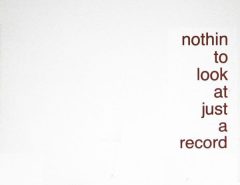Playing the Building: An Installation by David Byrne
The Battery Maritime Building
10 South Street, New York, NY
31 May – 24 August 2008
Open Friday, Saturday, Sunday: Noon – 6PM (Free)
Creative Time presents Playing the building, a sound installation in which the infrastructure, the physical plant of the building, is converted into a giant musical instrument. Devices are attached to the building structure — to the metal beams and pillars, the heating pipes, the water pipes — and are used to make these things produce sound. The activations are of three types: wind, vibration, striking. The devices do not produce sound themselves, but they cause the building elements to vibrate, resonate and oscillate so that the building itself becomes a very large musical instrument.
[…] Anne Pasternak (curator of the work): I was impressed recently with a quote from Alvin Lucier that stated, «Careful listening is more important than making sounds happen.» Does this sentiment play a role in your approach to Playing the Building ?
David Byrne: This piece makes the act of «careful listening» incredibly easy. There’s almost no effort involved except going to the space. One doesn’t have the same experience when reading a description of it—one has to be physically present to really listen.
AP: I find it really interesting to consider that humans are exposed to more sounds than ever before. With this project, you seem to advocate that people pay attention to the sounds inherent in everyday surroundings and materials. Why?
DB: I’d like to say that in a small way it turns consumers into creative producers, but that might be a bit too much to claim. However, even if one doesn’t play the thing, it points toward a less mediated kind of cultural experience. It might be an experience in which one begins to reexamine one’s surroundings and to realize that culture—of which sound and music are parts—doesn’t always have to be produced by professionals and packaged in a consumable form.
I’m not suggesting people abandon musical instruments and start playing their cars and apartments, but I do think the reign of music as a commodity made only by professionals might be winding down. The imminent demise of the large record companies as gatekeepers of the world’s popular music is a good thing, for the most part.
AP: With Playing the Building , you seem to imply that everyone can take center stage, perform, and compose with their everyday surroundings.
DB: I’m not advocating a kind of «Wiki» world of culture; but I guess I am advocating less separation between cultural producers (the artists, writers, musicians, dancers, singers) and cultural consumers.
AP: New technologies make it easy for anyone to be a «musician» or «composer.» Though he criticized the authority of the composer, I suspect John Cage would cringe at how music is being produced with off-the-shelf composing software. Those programs don’t allow for real experimentation with sound.
DB: I think there is far too much music everywhere. I don’t mean music in the John Cage sense of car horns and cell phones ringing: I mean recorded music. I find it hard to concentrate on a conversation when there’s music playing in a bar, club, or office. I understand why it’s there, but it turns music into a space filler. […]
** BoingBoing TV: DB interviewed by Xeni Jardin / Battery Maritime Building, 2008




Leave a Reply